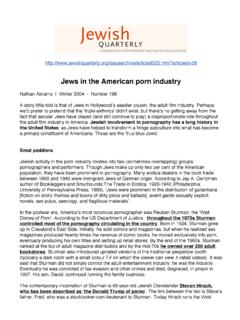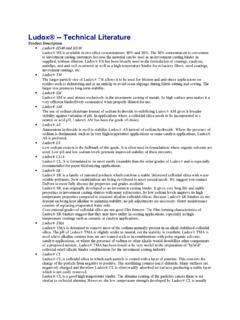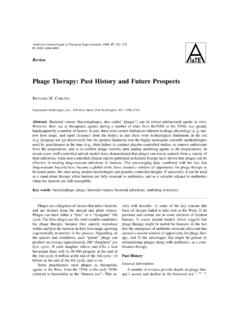Transcription of Imperial IPA - destroy
1 1 Imperial IPA:History, Brewing Techniques, Style Smith Brewing Network Sunday 6th, 200812 Imperial IPA Outline Introduction History Commercial Examples Example Recipes Key brewing points Style Evolution References2 IPA Introduction Intensely hoppy very strong American Pale Ale. Related to American Barleywine; without big/deep malt flavor and sweetness. Hops at all levels, yet clean, drinkable; not a heavy sipping beer. A showcase for hops, especially new high alpha American varieties. The SUV of beers Kevin Pratt, BJCP Grand Master I. BJCP category 14C highlights: Aroma: Intense hop aroma (cirtus, resin, floral, low/no grassy), low clean malt sweetness, low/no esters, low/no alcohol. No diacetyl. Appearance: Golden amber to medium reddish copper. Clear to hazy. Good off white foam stand. Flavor: Strong, complex hop flavor.
2 High to absurdly high hop bitterness balanced with malt backbone. Low to medium clean malt flavor; low caramel/toast OK. No diacetyl. Low/no fruity esters. Long lingering bitterness in aftertaste. Medium dry to dry finish. Clean smooth alcohol flavor. Oak is inappropriate. Slight sulfur OK, not common. Mouthfeel: Medium light to medium body. No hop astringency. Moderate to high carbonation. Medium to low alcohol warming. OG: , FG: , IBU: 60 120, SRM: 8 15, ABV: 10% A Style that is still evolving and changing!3 IPA history 1800s First beer brewed specifically for export to India brewed by George Hodgson in London, 1790 (4). Hodgson monopolized the India Ale export business until approximately 1820 (4). According to legend, a wrecked cargo in 1827 off the port of Liverpool of Bass East India Pale Ale was rescued and found great favor with the locals thus making it available to the English non military.
3 India Ale Hopping rates probably added up to 45 to 60 IBU's (3). Hodgson s India Ale hopped at a rate of Per US 5 gallons, approximately 70 ounces per US barrel.(4). Multiple hop additions and limited contact time were common during wortproduction: hops only kept in wort for 30 minutes before being removed , 4 separate charges total and a 2 hour boil. India Ale in the 1800s was probably a 7 8% beer at the time of export to India. Considerable evidence exists in the form of sales receipts and storage manifests that the product was watered down upon arrival before IPA to Imperial IPA 1994 1999 First modern commercial example from Vinnie Cilurzo. Inaugural brew at Blind Pig in Temecula, CA June 1994. Aged in Oak for 9 months and first served at the brewery s first anniversary. Became an annual anniversary brew thereafter (10).
4 Our brew was a lower ABV double IPA, only like , we doubled the hops and raised the malt by a little. It was so bitter it was like licking the rust off a tin can. With such a low ABV the hops really came through. Vinnie Cilurzo Rouge I2PA debuted at the Oregon Brewer s Festival in 1996. Stone Second Anniversary Ale, 1998. Eugene, OR 1998 Spring Beer Festival Style: Imperial IPA (10).5 Blind Ping 2ndAnniversary 1995 Rogue I2PA 1996 Stone 2ndAnniversary 19986 Imperial IPAGABF Commercial Examples 2001 GABF: Steelhead Hopasaurus Rex Gold, other Strong Ales category First appeared as separate GABF category, 40 in 2003. Pizza Port Frank (gold 2003 silver 2004) Russian River Pliny the Elder (GABF gold 2005 2006, Bronze 2007) Moylan s Hopsickle (gold 2007)6 Russian River Pliny the Elder, 2008 Pizza Port Frank, 2003 Moylan s Hopsickle7 Imperial IPABJCP examples First appeared in the 2004 guidelines, Category 14C.
5 Commercial Examples from the 2008 guidelines: Three Floyd s Dreadnaught, Avery Maharaja, Bell s Hop Slam, Stone Ruination, Great Divide Hercules Double IPA, Surly Furious, Rogue I2PA, Dogfish Head 90 Minute, Victory Hop Floyds DreadnaughtDogfish Head 90 Minute (Original bottle)Avery Maharaja Rogue I2PA (current bottle) 8 Imperial IPAE xample Recipes Homebrew take offs on Pliny the Elder Nathan s recipe: on the lower OG/FG end of the style with a Summit kick. McDole s recipe: on the higher OG/FG end of the style with a Northern Brewer kick. Consider using these as a starting point, then experiment and make it your own. Adapt to your own equipment, raw materials, techniques, preferences. Lots of room for IPA Brewing Tips Water Excess Magnesium can cause non hop derived astringent bitterness. Sulfate in moderate amounts can lend a crisp, dry finish.
6 In high amounts, it can have a harsh, salty flavor and negatively impact hop utilization. High carbonate water can give an impression of harsh hop bitterness; not to mention negative color impact, poor protein/tannin separation during hot/cold break. Be careful with concentrations exceeding 50ppm. Low/moderate Chloride (from CaCl, MgCl) can roundness, fullness on palate. Over 400ppm Cl can have a pasty flavor, over 500ppm it can negatively influence yeast activity. If you re adjusting for Ca already, consider CaSO4, CaCl or a blend of the IPAB rewing Tips Malt and mashing 70 80% Base malt: Domestic 2 row pale majority, small amounts of Maris Otter, Vienna, Munich, Pils OK. 1% Wheat OK. 5 10% dextrin malts: Domestic Crystal 10 40, Briess Carapils, Experiment with 1 2% Higher kilned crystal (60 80L) or maybe even a touch of a roasted malt.
7 Other possibilities: Victory, amber, speical roast. Only 2 row malt, no specialty malts: Rogue I2PA, Dogfish 90 minute. Too much crystal malt muddies up the hop flavors, use lower % of crystal malts for a crisp, clean hop flavor. Crystal malt clashes with bitter hop flavors. 1% crystal malt on the Elder, 0% crystal malt on the Younger (Vinnie Cilurzo, TBN 8/14/2005 2:01:37). 5 15% Simple sugar (corn, turbinado) to dry out the beer, consider a mash temperature that promotes beta amylase enzyme activity (148 152F). Monitor pH carefully to avoid polyphenol extraction during mash & Hops at all levels Consider: Mash, Sparge (FWH), All stages of the boil, just before cooling (hop back), just after cooling, dry hopping (after fermentation), at serving (dry hopping in tank, Randall). Less common methods Mash hopping and/or First Wort hopping More successful in low hopped beers and with hops that have a high humulenecontent (9).
8 Suggested hop addition rate for first wort hopping is 30% of the total kettle program (aroma additions) without further adjustment (9). Tom O Brien One of the first homebrewers credited with hopping the hot liquor IPAB rewing Tips Hop additions11 Hop back, side view ( )Hop back, top view ( )12 Imperial IPAB rewing Tips Hop selection American high alpha acid recommended for all additions, blend for complexity and consistency. For bittering IBUs Use 70 80% low cohumulone such as Warrior, Magnum or Horizon; 20 30% rough citrus, pepper or pine bittering hop such as Chinook, Columbus for some complexity (Vinnie TBN 8/13/2005 2:00:32) Oil content and aromatic quality importance proportional to how late in the process the hop is being used. Make hop tea of unknown varieties to evaluate flavor and aroma qualities.
9 Don t be afraid to explore. Example: Hersbrucker used in Alpine Brewing Pure IPA Hop aroma and IPAB rewing Tips Hop formats Flowers quick deterioration, tough to store, lupulin in purest form slower release of hop oils, a little more soft, well rounded (10). Plugs Middle ground between flowers and pellets. Very few, if any varieties available commonly to homebrewers. Pellets Stable, low oxygen, good storage, pressure during production creates heat, oxidizes some compounds, oil loss. Ruptured lupulin glands, a little more direct & In your face. Quick release of acids and potential volatilization of oils. Pellet hops can oxidize more rapidly than whole (9).Non ruptured Lupulin Glands (14)Ruptured Lupulin Gland (14)Whole Flower, Split (14)15 Imperial IPAB rewing Tips Hop extract Hop extracts Advantages: reduced cost, stored at room temperature, increased utilization, consistency, down stream applications (post fermentation), micro stability.
10 And with modified hop extracts, improved foam characteristics and light stability (9). Hop extracts disadvantages: flavor matching, whole hop character (aroma) can be difficult (9). World Production % breakdown, 2005 estimate: 35% extracts, 35% pellets, 10% whole hops, 25% isomerized and reduced products (13). Geir Ove Gr nmo, Oslo, hop extract from IPAB rewing Tips Dry Hopping Dry hopping = extraction of hop oils. Essential for the Imperial IPA style. Multiple dry hops, use less at each dry hopping stage, but dry hop more frequently Bigger aroma, Longer lasting aroma, Closer to sticking your head in a bag of fresh hops (7). Pliny the Younger One new dry hop added each week, 4 dry hops total over a 4 weekperiod (7). Dry hop after pulling the yeast. Dry hop warm (60 68F). Russian River Blend of pellet and flowers, flowers used more commonly at the end of the dry hopping process (7).







